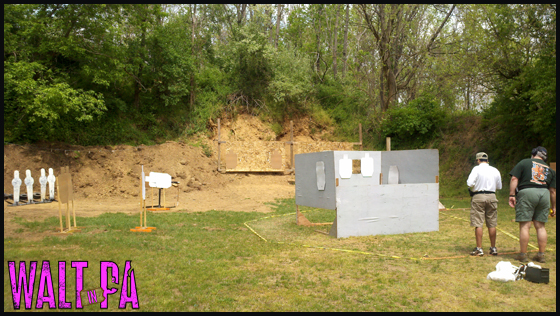
Yesterday I had the pleasure of attending the April 2012 USPSA Shooting match at Southern Chester County Sportsman’s and Farmers’ Association. The match was made up of 7 Stages that varied from a simple 8 Round Classifier stage to spread out 32 Round Field Courses.
One of the things that makes USPSA Shooting so appealing to me is its freestyle nature. Shooters are read a Written Stage Briefing and given five minutes to formulate a plan of attack. I tend to be more of a conservative shooter, trading off speed for accuracy. However, having recently read an interesting post from When The Balloon Goes Up on Creating a Game Plan , I began to weigh the risks and rewards of a given field course.
, I began to weigh the risks and rewards of a given field course.
This particulate stage consisted of 13 Static IPSC Metric Targets, 4 Pepper Poppers, and 1 Swinging IPSC Metric Target. All of these targets, with the exception of three, were situated around an island (the remaining three were inside, tucked behind a low wall). The first choice each shooter needed to make was which way to go around the island.
I felt that it was in my best interest to remain stationary at the start signal and shoot two paper targets to my right. I would then move forward to engage the low targets within the island, then work the stage around the left side of the island. The next decision was to determine how aggressive I wanted to be.
Low Risk – Small Reward:
Being a Production Division Shooter, we essentially have 11 rounds to work with. During the load and make ready command, we load a round into the chamber, then insert a magazine filled to division capacity (10 Rounds). Having 11 rounds in the gun means that we can fire ten rounds before going to slide-lock.
A safe game plan for this stage would be to engage two paper targets on the shooters right, then move forward and engage three targets within the center island. At this point the shooter has fired ten rounds (pending no make-up shots were fired). A reload would be performed while the shooter moves to their left.
Two paper targets, separated by a penalty target, are engaged before transitioning to four steel pepper poppers. The shooter would engage the far-right steel first to engage the swinger. The remaining three steel poppers would be engaged. In the event that the steel took multiple shots to knock down, a reload would be performed.
The shooter would then move to their right and engage two paper targets situated at the rear of the pistol pit. The shooter would turn to their left and engage the swinger which has had a chance to slow down. One last reload would be performed while the shooter moved to their right. Through a port, two near and two far targets would be engaged to close out the stage.
The low risk, in this case, is transitioning away from the swinger and coming back to it. While this would make the swinger easier to hit, the shooter burns up time in an effort to slow it down. The video below shows my fellow teammate, Dave, shooting the stage in this low-risk fashion.
Dave Shooting Stage 1 at Southern Chester
High Risk – Big Reward:
My first three matches of the season have been with the mindset that I would trade speed for accuracy. This mindset has done well for me in those matches but as Martin Lawrence once said, “sometimes you got to feed a little speed to your ride”.
There was actually two risky parts to my plan. The first was that I intended to exhaust my tenth round activating the swinger and would need to reload and have my gun in a position to fire before the swinger disappeared. My goal was to place two shots on the swinger at the end of its swing, to ambush it. In the past I have had major accuracy issues chasing swingers, so I wanted to avoid that as well as waiting for the swinger to disappear and come back into view again.
The second risk was that I planned three strings of fire which used ten rounds. If I missed a shot and had to make it up, I would run into issues with round count and my rhythm would be affected. Just to recap, I was planning on shooting quickly, hitting all of my targets with each round fired, and I would need to perform a reload in a small window.
At the start I engaged a pair of targets on my right, before moving forward to engage three targets within the island. I performed a reload on the move and engaged a pair of paper targets, separated by a penalty target, while I moved around the left side of the island. I then engaged four steel poppers, on the move, and exhausted my tenth round.
I performed a reload while the last popper fell and activated the swinger. I fired two rounds on the swinger on its first showing and continued moving around the island. I engaged four targets at the rear of the stage, performed a reload, and engaged the last two remaining targets through a port.
Walt Shooting Stage 1 at Southern Chester
The Right Plan for You:
The beauty of USPSA Shooting is that there is such a wide variety of options. Each shooter tackled this stage a little differently. Some plans were slow and steady, others were like an all out sprint to the finish. When you step onto a stage and begin your five-minute walkthrough, weigh your options and pick the one that best suits your abilities.
This time I decided to take a gamble. I’ve never felt very comfortable shooting on the move and I surprised myself with how well I performed on this stage. It just goes to show that it never hurts to expand your game and try new things from time to time.
Recent Posts
When most people think about Motorcycle Group Rides, I believe it conjures up images of large packs of Harley Davidson Motorcycles riding for a cause. While there is no shortage of these types of...
On June 18, 2023, I went for a Father's Day Motorcycle Ride to Lancaster, PA, to see a historic covered bridge. I was stopped at a traffic light at the intersection of PA Rt 422 East and PA Rt 82...
